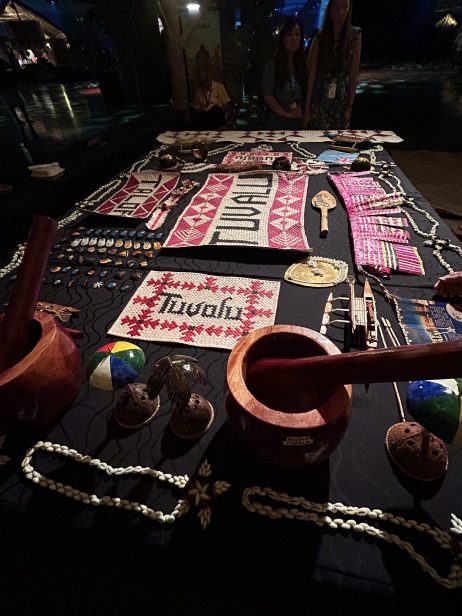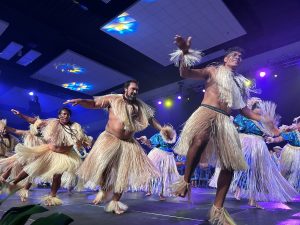Pacific Island nations face significant threats of cultural erosion due to globalization, modernization, and external influences. Traditional practices, art forms, and languages are at risk of disappearing as younger generations may gravitate toward more dominant global cultures. This erosion can lead to a loss of cultural identity and heritage, which are vital for the social cohesion and historical continuity of these communities.
Against that backdrop, the Festival of Pacific Arts and Culture (FestPAC) serves a multifaceted role in the cultural landscape of the Pacific Islands. Typically held every four years, but paused since 2016 due to the COVID-19 pandemic, the 13th iteration of the festival convened delegates from 27 countries and territories in Honolulu, Hawai’i, from June 6 to June 16.
To understand the importance, as well as the continuing relevance of FestPAC, it is essential to highlight its history. The first proposal of a festival to celebrate Pacific culture came in 1968 at the 8th South Pacific Conference. Co-sponsored by the Fiji Arts Council and the Pacific Community (SPC), then known as the South Pacific Commission, the first official FestPAC took place in 1972 in Suva, Fiji, and brought together more than 1,00 participants from 14 countries and territories. Following its first iteration, the South Pacific Arts Festival Council was established in 1975 to guarantee that the event became permanent. The festival’s location rotates to a different city in the Pacific each time, with examples of previous hosts including French Polynesia in 1984, Samoa in 1996, and the Solomon Islands in 2012.
This year, the Hawai’i Convention Center acted as the main location for the festival, with each delegation hosting a booth in Festival Village. On display were many traditional cultural items ranging from hand-woven mats and fans to jewelry to clothing. Elders taught weaving techniques using pandanus leaves to those passing by, while other stalls featured live canvas paintings. Throughout the festival, countries performed traditional dances and showcased some of their typical clothing on the main stage within the convention center. Other locations in the City of Honolulu such as the Bishop Museum, Kualoa Regional Park, and the Royal Hawaiian Center hosted events during the 11-day festival.

Handmade arts on display at Tuvalu’s booth at FestPAC 2024. Photo by John Augé
FestPAC provides an essential platform for showcasing and celebrating the traditional practices, art forms, and languages of Pacific Island countries. On-stage performances along with sessions focused on traditional tattoo and carving techniques not only preserve these traditions but also educate and inspire both participants and audiences about the rich cultural tapestry of the Pacific.
The festival plays a crucial role in fostering cultural identity and pride among Pacific Islanders. Youth participants have expressed the joy FestPAC brought to them as it is an opportunity for traditional knowledge to be passed down as well as for showcasing what they have learned. By highlighting and honoring their traditions, the festival strengthens the community’s connection to their heritage. This reinforcement of cultural identity is particularly important for younger generations, offering them a sense of pride and belonging.
The gathering promotes a sense of regional unity and cultural understanding by emphasizing commonalities and celebrating diversity among Pacific Island nations. Despite the diversity of Pacific languages, a fascinating display at one stall featured whiteboards where delegates could write words in their native tongues. The resulting compilation revealed surprising similarities, hinting at the deep-rooted cultural connections that bind these island nations. FestPAC encourages dialogue and cooperation, strengthening bonds between communities. This sense of unity is crucial in addressing shared challenges and advancing collective goals.
FestPAC brings together artists and cultural practitioners, creating a dynamic environment for collaboration and exchange. Delegates shared knowledge, stories, and artistic expressions, fostering mutual respect, and understanding among different cultures while enjoying kava, a common drink in the South Pacific. Artists can learn from each other’s techniques and perspectives, enriching their practices and contributing to the collective cultural wealth.
While rooted in tradition, FestPAC also provides a stage for addressing contemporary issues faced by Pacific Island nations, such as climate change and rising sea levels. These environmental challenges pose significant threats to the region, and the festival serves as a forum for discussing and raising awareness about these issues. “Rising Seas & Refugees,” “Conservation Challenges,” and “He Kau Heahea a Hiʻiaka” – Dances of Climate Change by Kamehameha Schools Hawaiian Ensemble are examples of events that were held at the festival this year focused on climate change. By bringing together diverse voices, FestPAC inspires collaboration and the development of innovative solutions to these pressing problems.
The collaborative spirit fostered by FestPAC leads to the creation of networks and partnerships that extend beyond the festival. This year, more than 500,000 people attended. A delegate from Kiribati explained that he created a group chat with one member from each delegation with the purpose of staying in touch after the festival ended. These connections can inspire initiatives and projects aimed at addressing both cultural preservation and contemporary challenges. By uniting people with shared concerns and passions, FestPAC helped catalyze collective action and drive positive change.
FestPAC’s significance extends far beyond a mere celebration of tradition. It stands as a powerful platform for cultural preservation, fostering identity, and promoting regional unity. As the Pacific navigates the challenges of globalization and environmental threats, the event offers a space for collaboration, innovation, and collective action. By fostering dialogue, sharing knowledge, and inspiring creativity, FestPAC ensures that the unique voices and vibrant traditions of the Pacific Islands continue to resonate not just within the region, but on the world stage. The future of the festival holds immense potential, evolving into a catalyst for not only remembering the past but also shaping a brighter future for the Pacific.

































